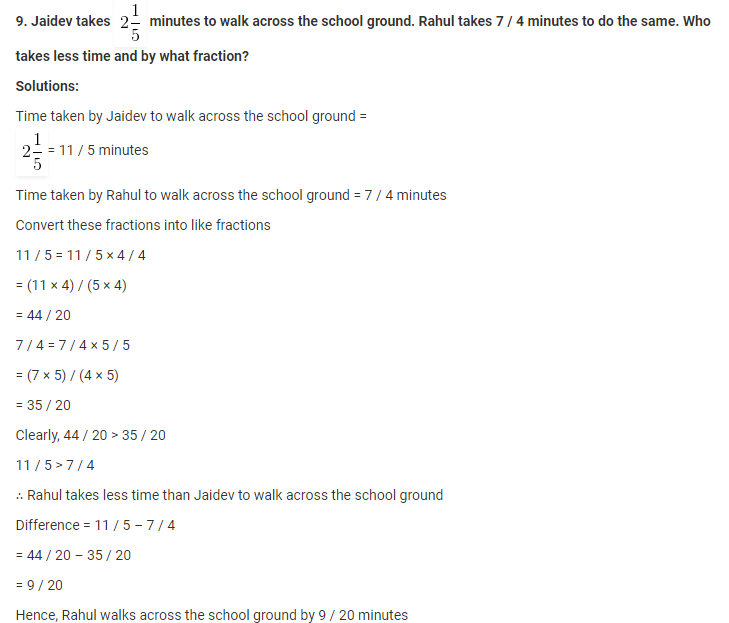Topics and Sub Topics in Class 6 Maths Chapter 7 Fraction
| Section Name | Topic Name |
| 7.1 | Introduction |
| 7.2 | A Fraction |
| 7.3 | Fraction on the Number Line |
| 7.4 | Proper Fractions |
| 7.5 | Improper and Mixed Fractions |
| 7.6 | Equivalent Fractions |
| 7.7 | Simplest Form of a Fraction |
| 7.8 | Like Fractions |
| 7.9 | Comparing Fractions |
| 7.9.1 | Comparing Like Fractions |
| 7.9.2 | Comparing Unlike Fractions |
| 7.10 | Addition and Subtraction of Fractions |
| 7.10.1 | Adding or Subtracting like fractions |
| 7.10.2 | Adding or Subtracting fractions |
| 7.10.3 | How do we add or Subtract mixed fractions |
Fractions Class 6 Ex 7.1
Ex 7.1 Class 6 Maths Question 1.
Write the fraction representing the shaded portion.
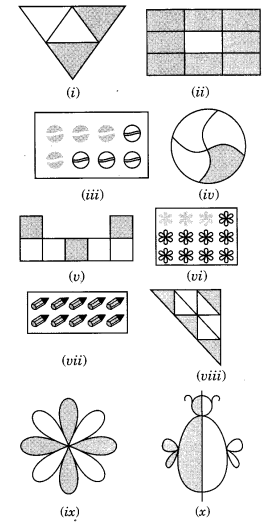
Solution:
(i) Total number of parts = 4
Number of shaded parts = 2
∴ Fraction = (frac { 2 }{ 4 })
(ii) Total number of parts = 9
Number of shaded parts = 8
∴ Fraction = (frac { 8 }{ 9 })
(iii) Total number of parts = 8
Number of shaded parts = 4
∴ Fraction = (frac { 4 }{ 8 })
(iv) Total number of parts = 4
Number of shaded parts = 1
∴ Fraction = (frac { 1 }{ 4 })
(v) Total number of parts = 7
Number of shaded parts = 3
∴ Fraction = (frac { 3 }{ 7 })
(vi) Total number of parts = 12
Number of shaded parts = 3
∴ Fraction = (frac { 3 }{ 12 })
(vii) Total number of parts = 10
Number of shaded parts = 10
∴ Fraction = (frac { 10 }{ 10 })
(viii) Total number of parts = 9
Number of shaded parts = 4
∴ Fraction = (frac { 4 }{ 9 })
(ix) Total number of parts = 8
Number of shaded parts = 4
∴ Fraction = (frac { 4 }{ 8 })
(x) Total number of parts = 2
Number of shaded part = 1
∴ Fraction = (frac { 1 }{ 2 })
Ex 7.1 Class 6 Maths Question 2.
Colour the part according to the given fraction.
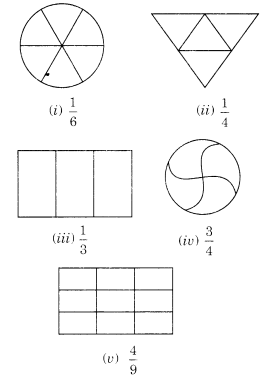
Solution:
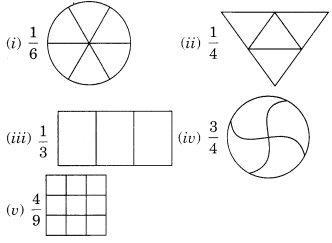
Ex 7.1 Class 6 Maths Question 3.
Identify the error, if any.
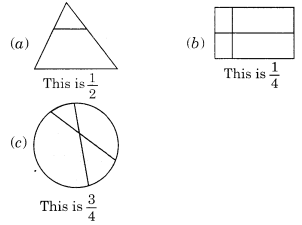
Solution:
(a) Since the shaded part is not half.
∴ This is not (frac { 1 }{ 2 }).
(b) Since, the parts are not equal.
∴ Shaded part is not (frac { 1 }{ 4 }) .
(c) Since, the part are not equal.
∴ Shaded part is not (frac { 3 }{ 4 }).
Ex 7.1 Class 6 Maths Question 4.
What fraction of a day is 8 hours?
Solution:
Since, a day has 24 hours and we have 8 hours,
∴ Required fraction = (frac { 8 }{ 24 })
Ex 7.1 Class 6 Maths Question 5.
What fraction of a hour is 40 minutes?
Solution:
Since I hours = 60 minutes
∴ Fraction of 40 minutes = (frac { 40 }{ 60 })
Ex 7.1 Class 6 Maths Question 6.
Arya, Abhimanyu and Vivek shared lunch. Arya has brought two sandwiches, one made of vegetable and one of Jam. The other two boys forgot to bring their lunch. Arya agreed to share his sandwiches so that each person will have an equal share of each sandwich.
(a) How can Arya divide his sandwiches so that each person has an equal share?
(b) What part of a sandwich will each boy receive?
Solution:
(a) Arya has divided his sandwich into three equal parts.
So, each of them will get one part.
(b) Each one of them will receive (frac { 1 }{ 3 }) part.
∴ Required fraction = (frac { 1 }{ 3 })
Ex 7.1 Class 6 Maths Question 7.
Kanchan dyes dresses. She had to dye 30 dresses. She has so far finished 20 dresses. What fraction of dresses has she finished?
Solution:
Total number of dresses to be dyed = 30
Number of dresses finished = 20
∴ Required fraction = (frac { 20 }{ 30 }) = (frac { 2 }{ 3 })
Ex 7.1 Class 6 Maths Question 8.
Write the natural numbers from 2 to 12. What fraction of them are prime numbers?
Solution:
Natural numbers between 2 and 12 are;
2,3,4, 5, 6, 7, 8, 9, 10,11, 12
Number of given natural numbers = 11
Number of prime numbers = 5
∴ Required fraction = (frac { 5 }{ 11 })
Ex 7.1 Class 6 Maths Question 9.
Write the natural numbers from 102 to 113. What fraction of them are prime numbers?
Solution:
Natural numbers from 102 to 113 are;
102,103,104,105,106, 107,108, 109,110, 111, 112,113
Total number of given natural numbers = 12
Prime numbers are 103, 107, 109, 113
∴ Number of prime numbers = 4
∴ Required fraction = (frac { 4 }{ 12 }) = (frac { 1 }{ 3 })
Ex 7.1 Class 6 Maths Question 10.
What fraction of these circles have X’s in them?

Solution:
Total number’of circles = 8
Number of circles having X’s in them = 4
Required fraction = (frac { 4 }{ 8 }) = (frac { 1 }{ 2 })
Ex 7.1 Class 6 Maths Question 11.
Kristin received a CD player for her birthday. She bought 3 CDs and received 5 others as gifts. What fraction of her total CDs did she buy and what fraction did she receive as gifts?
Solution:
Number of CDs bought by her from the market = 3
Number of CD’s received as gifts = 5
∴ Total number of CDs = 3 + 5 = 8
∴ Fraction of CD (bought) = (frac { 3 }{ 8 }) and the fraction of CDs (gifted) = (frac { 5 }{ 8 })
Fractions Class 6 Ex 7.2
Ex 7.2 Class 6 Maths Question 1.
Draw number lines and locate the points on them.

Solution:
 We have divided the number line from 0 to 1 into four equal parts.
We have divided the number line from 0 to 1 into four equal parts.
C represents (frac { 2 }{ 4 }) i,e., (frac { 1 }{ 2 })
B represents (frac { 1 }{ 4 })
D represents (frac { 3 }{ 4 })
and E represents (frac { 4 }{ 4 }) , i.e., 1.
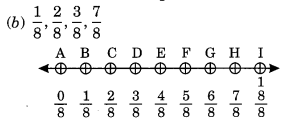
We have divided the number line from 0 to 1 into eight equal parts.
B represents (frac { 1 }{ 8 })
C represents (frac { 2 }{ 8 })
D represents (frac { 3 }{ 8 })
and H represents (frac { 7 }{ 8 })
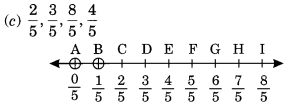
From the above number line, we have
C represents (frac { 2 }{ 5 })
D represents (frac { 3 }{ 5 })
E represents (frac { 4 }{ 5 })
and I represents (frac { 8 }{ 5 })
Ex 7.2 Class 6 Maths Question 2.
Express the following as mixed fractions:

Solution:


Ex 7.2 Class 6 Maths Question 3.
Express the following as improper fractions:

Solution:

Fractions Class 6 Ex 7.3
Ex 7.3 Class 6 Maths Question 1.
Write the fractions. Are all these fractions equivalent?

Solution:

Since all the fractions in their simplest form are not equal.
∴ They are not equivalent fractions.
Ex 7.3 Class 6 Maths Question 2.
Write the fractions and pair up the equivalent fractions from each row.
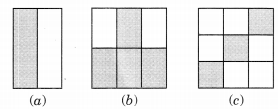
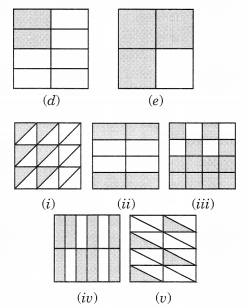
Solution:
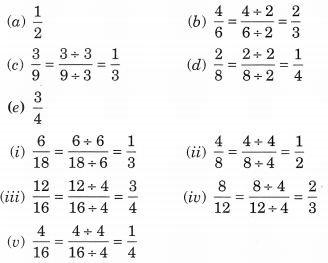
The following pairs fractions:represent the equivalent fractions.
(a) and (ii) = (frac { 1 }{ 2 })
(b) and (iv) = (frac { 2 }{ 3 })
(c) and (i) = (frac { 1 }{ 3 })
(d) and (v) = (frac { 1 }{ 4 })
(e) and (iii) = (frac { 3 }{ 4 })
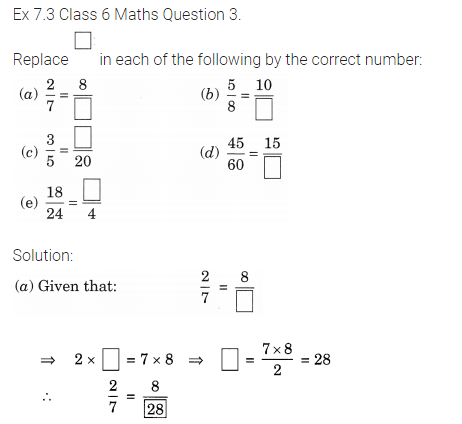
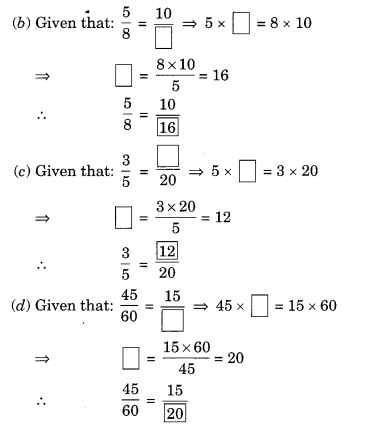
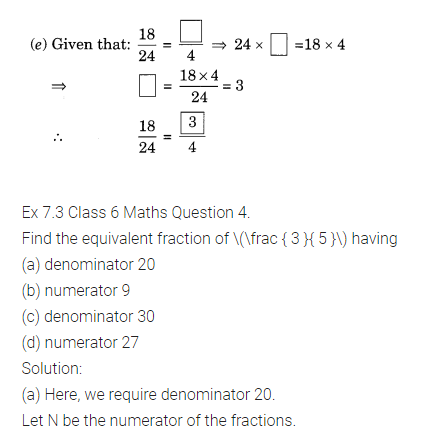

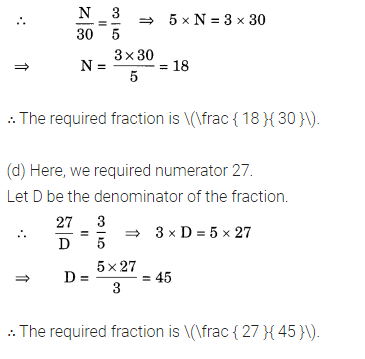
Ex 7.3 Class 6 Maths Question 5.
Find the equivalent fraction of (frac { 36 }{ 48 }) with
(a) numerator 9
(b) denominator 4
Solution:
(a) Given that numerator = 9

So, the equivalent fraction is (frac { 9 }{ 12 }).
(b) Given that denominator = 4
∴ (frac { N }{ 4 }) = (frac { 36 }{ 48 }) ⇒ N x 48 = 4 x 36
⇒ N = (frac { 4 x 36 }{ 48 }) = 3
So, the equivalent fraction is (frac { 3 }{ 4 }) .
6. Check whether the given fractions are equivalent:
(a) 5 / 9, 30 / 54
(b) 3 / 10, 12 / 50
(c) 7 / 13, 5 / 11
Solutions:
(a) Given 5 / 9 and 30 / 54
We have 5× 54 = 270
9 × 30 = 270
5 × 54 = 9 × 30
Hence, 5 / 9 and 30 / 54 are equivalent fractions
(b) Given 3 / 10 and 12 / 50
We have 3 × 50 = 150
10 × 12 = 120
3 × 50 ≠ 10 × 12
Hence, 3 / 10 and 12 / 50 are not equivalent fractions
(c) Given 7 / 13 and 5 / 11
We have 7 × 11 = 77
5 × 13 = 65
7 × 11 ≠ 5 × 13
Hence, 7 / 13 and 5 / 11 are not equivalent fractions
7. Reduce the following fractions to simplest form:
(a) 48 / 60
(b) 150 / 60
(c) 84 / 98
(d) 12 / 52
(e) 7 / 28
Solutions:
(a) 48 / 60 = (12 × 4) / (12 × 5)
= 4 / 5
(b) 150 / 60 = (30 × 5) / (30 × 2)
= 5 / 2
(c) 84 / 98 = (14 × 6) / (14 × 7)
= 6 / 7
(d) 12 / 52 = (3 × 4) / (13 × 4)
= 3 / 13
(e) 7 / 28 = 7 / (7 × 4)
= 1 / 4
8. Ramesh had 20 pencils, Sheelu had 50 pencils and Jamaal had 80 pencils. After 4 months, Ramesh used up 10 pencils, Sheelu used up 25 pencils and Jamaal used up 40 pencils. What fraction did each use up? Check if each has used up an equal fraction of her/his pencils?
Solutions:
Total number of pencils Ramesh had = 20
Number of pencils used by Ramesh = 10
∴ Fraction = 10 / 20 = 1 / 2
Total number of pencils Sheelu had = 50
Number of pencils used by Sheelu = 25
∴ Fraction = 25 / 50 = 1 / 2
Total number of pencils Jamaal had = 80
Number of pencils used by Jamaal = 40
∴ Fraction = 40 / 80 = 1 / 2
Yes, each has used up an equal fraction of pencils i.e 1 / 2
9. Match the equivalent fractions and write two more for each.
(i) 250 / 400 (a) 2 / 3
(ii) 180 / 200 (b) 2 / 5
(iii) 660 / 990 (c) 1 / 2
(iv) 180 / 360 (d) 5 / 8
(v) 220 / 550 (e) 9 / 10
Solutions:
(i) 250 / 400
= (5 × 50) / (8 × 50)
= 5 / 8
25 / 40 and 30 / 48 are two more fractions
(ii) 180 / 200
= (9 × 20) / (10 × 20)
= 9 / 10
18 / 20 and 27 / 30 are two more fractions
(iii) 660 / 990
= (2 × 330) / (3 × 330)
= 2 / 3
20 / 30 and 200 / 300 are two more fractions
(iv) 180 / 360
= (1 × 180) / (2 × 180)
= 1 / 2
20 / 40 and 30 / 60 are two more fractions
(v) 220 / 550
= (2 × 110) / (5 × 110)
= 2 / 5
20 / 50 and 40 / 100 are two more fractions
∴ The equivalent fractions are
(i) 250 / 100 = (d) 5 / 8
(ii) 180 / 200 = (e) 9 / 10
(iii) 660 / 990 = (a) 2 / 3
(iv) 180 / 360 = (c) 1 / 2
(v) 220 / 550 = (b) 2 / 5
Exercise 7.4 page no: 152
1. Write shaded portion as fraction. Arrange them in ascending and descending order using correct sign ‘’ between the fractions:
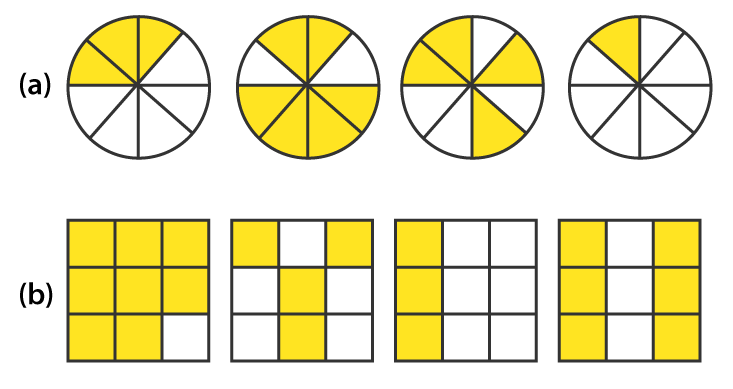
c) Show 2 / 6, 4 / 6, 8 / 6 and 6 / 6 on the number line. Put appropriate signs between the fractions given.
5 / 6 ☐ 2 / 6, 3 / 6 ☐ 0, 1 / 6 ☐ 6 / 6, 8 / 6 ☐ 5 / 6
Solutions:
(a) First circle shows 3 shaded parts out of 8 equal parts. Hence, the fraction is 3 / 8
Second circle shows 6 shaded parts out of 8 equal parts. Hence, the fraction is 6 / 8
Third circle shows 4 shaded parts out of 8 equal parts. Hence, the fraction is 4 / 8
Fourth circle shows 1 shaded parts out of 8 equal parts. Hence, the fraction is 1 / 8
The arranged fractions are:
1 / 8 < 3 / 8 < 4 / 8 < 6 / 8
(b) First square shows 8 shaded parts out of 9 equal parts. Hence, the fraction is 8 / 9
Second square shows 4 shaded parts out of 9 equal parts. Hence, the fraction is 4 / 9
Third square shows 3 shaded parts out of 9 equal parts. Hence, the fraction is 3 / 9
Fourth square shows 6 shaded parts out of 9 equal parts. Hence, the fraction is 6 / 9
The arranged fractions are:
3 / 9 < 4 / 9 < 6 / 9 < 8 / 9
(c) Each unit length should be divided into 6 equal parts to represent the fractions 2 / 6, 4 / 6, 8 / 6 and
6 / 6 on number line. These fractions can be represented as follows:

5 / 6 > 2 / 6
3 / 6 > 0
1 / 6 < 6 / 6
8 / 6 > 5 / 6
2. Compare the fractions and put an appropriate sign.
(a) 3 / 6 ☐ 5 / 6
(b) 1 / 7 ☐ 1 / 4
(c) 4 / 5 ☐ 5 / 5
(d) 3 / 5 ☐ 3 / 7
Solutions:
(a) Here both fractions have same denominators. So, the fraction with greater numerator is the highest factor
∴ 3 / 6 < 5 / 6
(b) Multiply by 4
1 / 7 = (1 × 4) / (7 × 4)
= 4 / 28
Multiply by 7
1 / 4 = (1 × 7) / (4 × 7)
= 7 / 28
Here 4 < 7
∴ 1 / 7 < 1 / 4
(c) Here both fractions have same denominators. So, the fraction with greater numerator is the highest factor
∴ 4 / 5 < 5 / 5
(d) Here both numerators are same. So, the fraction having less denominator will be the highest factor
∴ 3 / 7 < 3 / 5
3. Make five more such pairs and put appropriate signs.
Solutions:
(a) 5 / 8 < 6 / 8
Here, the denominators are same. So, the fraction having greater numerator is the highest factor
(ii) 5 / 8 > 2 / 8
Here, the denominators are same. So, the fraction having greater numerator is the highest factor
(iii) 6 / 13 > 6 / 18
Here, the numerators are same. So, the fraction having lesser denominator will be the highest factor
(iv) 5 / 25 > 3 / 25
Here, the denominators are same. So, the fraction having greater numerator is the highest factor
(v) 9 / 50 < 9 / 45
Here, the numerators are same. So, the fraction having lesser denominator will be the highest factor
4. Look at the figures and write ‘<’ or ‘>’, ‘=’ between the given pairs of fractions.
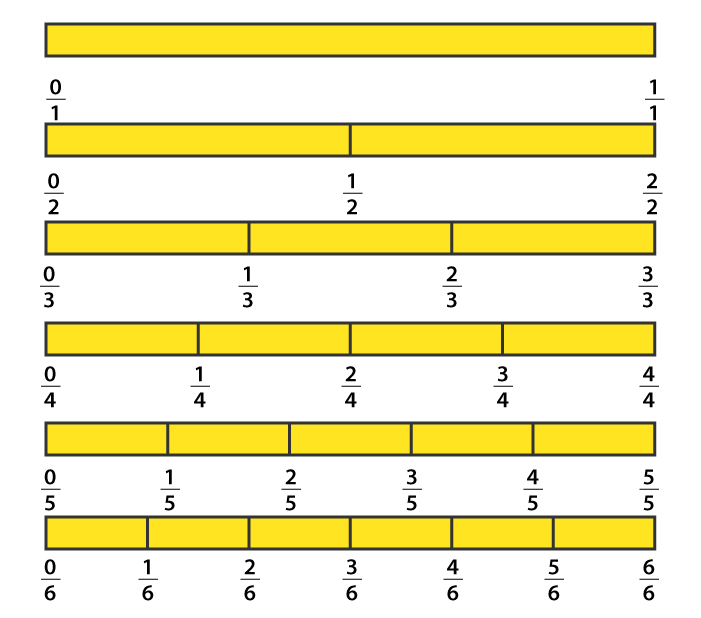
(a) 1 / 6 ☐ 1 / 3
(b) 3 / 4 ☐ 2 / 6
(c) 2 / 3 ☐ 2 / 4
(d) 6 / 6 ☐ 3 / 3
(e) 5 / 6 ☐ 5 / 5
Solutions:
(a) Here, the numerators are same. So, the fraction having lesser denominator is the greater
∴ 1 / 6 < 1 / 3
(b) 3 / 4 = (3 × 3) / (4 × 3)
= 9 / 12
2 / 6 = (2 × 2) / (6 × 2)
= 4 / 12
Between 4 / 12, 9 / 12
Both fractions have same denominators. So, the fraction having greater numerator will be the greater
∴ 9 / 12 > 4 / 12
3 / 4 > 2 / 6
(c) Here, the numerators are same. So, the fraction having lesser denominator is the greater
∴ 2 / 3 > 2 / 4
(d) We get 6 / 6 = 1 and 3 / 3 = 1
So, 6 / 6 = 3 / 3
(e) Here, the numerators are same. So, the fraction having lesser denominator is the greater
∴ 5 / 6 < 5 / 5
5. How quickly can you do this? Fill appropriate sign. ( ‘<’, ‘=’, ‘>’)
(a) 1 / 2 ☐ 1 / 5
(b) 2 / 4 ☐ 3 / 6
(c) 3 / 5 ☐ 2 / 3
(d) 3 / 4 ☐ 2 / 8
(e) 3 / 5 ☐ 6 / 5
(f) 7 / 9 ☐ 3 / 9
(g) 1 / 4 ☐ 2 / 8
(h) 6 / 10 ☐ 4 / 5
(i) 3 / 4 ☐ 7 / 8
(j) 6 / 10 ☐ 3 / 5
(k) 5 / 7 ☐ 15 / 21
Solutions:
(a) Here, the numerators are same. So, the fraction having lesser denominator is the greater
∴ 1 / 2 > 1 / 5
(b) 2 / 4 = 1 / 2 and 3 / 6 = 1 / 2
∴ 2 / 4 = 3 / 6
(c) 3 / 5 = (3 × 3) / (5 × 3)
= 9 / 15
2 / 3 = (2 × 5) / 3 × 5)
= 10 / 15
Here, between 9 / 15 and 10 / 15 both have same denominators. Hence, the fraction having greater numerator will be the greater.
∴ 3 / 5 < 2 / 3
(d) Here, 2 / 8 = 1 / 4
As, 3 / 4 and 1 / 4 have same denominators. Hence, the fraction having greater numerator will be the greater
∴ 3 / 4 > 2 / 8
(e) Here, the denominators are same. So, the fraction having greater numerator will be the greater
∴ 3 / 5 < 6 / 5
(f) Here, the denominators are same. So, the fraction having greater numerator will be the greater
∴ 7 / 9 > 3 / 9
(g) We know 2 / 8 = 1 / 4
Hence, 1 / 4 = 2 / 8
(h) 6 / 10 = (3 × 2) / (5 × 2)
= 3 / 5
Between 3 / 5 and 4 / 5
Both have same denominators. So, the fraction having greater numerator will be greater
∴ 6 / 10 < 4 / 5
(i) 3 / 4 = (3 × 2) / (4 × 2)
= 6 / 8
Between 6 / 8 and 7 / 8
Both have same denominators. So, the fraction having greater numerator will be greater
∴ 3 / 4 < 7 / 8
(j) 6 / 10 = (3 × 2) / (5 × 2)
= 3 / 5
∴ 6 / 10 = 3 / 5
(k) 5 / 7 = (5 × 3) / (7 × 3)
= 15 / 21
∴ 5 / 7 = 15 / 21
6. The following fractions represent just three different numbers. Separate them into three groups of equivalent fractions, by changing each one to its simplest form.
(a) 2 / 12 (b) 3 / 15 (c) 8 / 50 (d) 16 / 100 (e) 10 / 60 (f) 15 / 75
(g) 12 / 60 (h) 16 / 96 (i) 12 / 75 (j) 12 / 72 (k) 3 / 18 (l) 4 / 25
Solutions:
(a) 2 / 12 = (1 × 2) / (6 × 2)
= 1 / 6
(b) 3 / 15 = (1 × 3) / (5 × 3)
= 1 / 5
(c) 8 / 50 = (4 × 2) / (25 × 2)
= 4 / 25
(d) 16 / 100 = (4 × 4) / (25 × 4)
= 4 / 25
(e) 10 / 60 = (1 × 10) / (6 × 10)
= 1 / 6
(f) 15 / 75 = (1 × 15) / (5 × 15)
= 1 / 5
(g) 12 / 60 = (1 × 12) / (5 × 12)
= 1 / 5
(h) 16 / 96
= (1 × 16) / (6 × 16)
= 1 / 6
(i) 12 / 75 = (4 × 3) / (25 × 3)
= 4 / 25
(j) 12 / 72 = (1 × 12) / 6 × 12)
= 1 / 6
(k) 3 / 18 = (1 × 3) / (6 × 3)
= 1 / 6
(l) 4 / 25
Totally there are 3 groups of equivalent fractions.
1 / 6 = (a), (e), (h), (j), (k)
1 / 5 = (b), (f), (g)
4 / 25 = (c), (d), (i), (l)
7. Find answers to the following. Write and indicate how you solved them.
(a) Is 5 / 9 equal to 4 / 5
(b) Is 9 / 16 equal to 5 / 9
(c) Is 4 /5 equal to 16 / 20
(d) Is 1 / 15 equal to 4 / 30
Solutions:
(a) 5 / 9, 4 / 5
Convert these fractions into like fractions
5 / 9 = (5 / 9) × (5 / 5)
= 25 / 45
4 / 5 = (4 / 5) × (9 / 9)
= 36 / 45
∴ 25 / 45 ≠ 36 / 45
Hence, 5 / 9 is not equal to 4 / 5
(b) 9 / 16, 5 / 9
Convert into like fractions
9 / 16 = (9 / 16) × (9 / 9)
= 81 / 144
5 / 9 = (5 / 9) × (16 / 16)
= 80 / 144
∴ 81 / 144 ≠ 80 / 144
Hence, 9 / 16 is not equal to 5 / 9
(c) 4 / 5, 16 / 20
16 / 20 = (4 × 4) / (5 × 4)
= 4 / 5
∴ 4 / 5 = 16 / 20
Hence, 4 / 5 is equal to 16 / 20
(d) 1 / 15, 4 / 30
4 / 30 = (2 × 2) / (15 × 2)
= 2 / 15
∴ 1 / 15 ≠ 4 / 30
Hence, 1 / 15 is not equal to 4 / 30
8. Ila read 25 pages of a book containing 100 pages. Lalita read 2 / 5 of the same book. Who read less?
Solutions:
Total number of pages a book has = 100 pages
Lalita read = 2 / 5 × 100 = 40 pages
Ila read = 25 pages
∴ Ila read less than Lalita.
9. Rafiq exercised for 3 / 6 of an hour, while Rohit exercised for 3 / 4 of an hour. Who exercised for a longer time?
Solutions:
Rafiq exercised = 3 / 6 of an hour
Rohit exercised = 3 / 4 of a hour
3 / 6, 3 / 4
Convert these into like fractions
3 / 6 = (3 × 2) / (6 × 2)
= 6 / 12
3 / 4 = (3 × 3) / (4 × 3)
= 9 / 12
Clearly, 9 / 12 > 6 / 12
∴ 3 / 4 > 3 / 6
Therefore Rohit exercised for a longer time than Rafiq.
10. In a class A of 25 students, 20 passed with 60% or more marks; in another class B of 30 students, 24 passed with 60% or more marks. In which class was a greater fraction of students getting with 60% or more marks?
Solutions:
Total number of students in Class A = 25
Students passed in first class in Class A = 20
Hence, fraction = 20 / 25
= 4 / 5
Total number of students in Class B = 30
Students passed in first class in Class B = 24
Hence, fraction = 24 / 30
= 4 / 5
∴ An equal fraction of students passed in first class in both the classes
Exercise 7.5 page no: 157
1. Write these fractions appropriately as additions or subtractions:

Solutions:
(a) Total number of parts each rectangle has = 5
No. of shaded parts in first rectangle = 1 i.e 1 / 5
No. of shaded parts in second rectangle = 2 i.e 2 / 5
No. of shaded parts in third rectangle = 3 i.e 3 / 5
Clearly, fraction represented by third rectangle = Sum of the fractions represented by first and second rectangle
Hence, 1 / 5 + 2 / 5 = 3 / 5
(b) Total number of parts each circle has = 5
We may observe that first, second and third circles represent 5, 3 and 2 shaded parts out of 5 equal parts respectively. Clearly, fraction represented by third circle is the difference between the fractions represented by first and second circles.
Hence, 5 / 5 – 3 / 5 = 2 / 5
(c) Here we may observe that first, second and third rectangles represents 2, 3 and 5 shaded parts out of 6 equal parts respectively. Clearly, fraction represented by third rectangle is the sum of fractions represented by first and second rectangles.
Hence, 2 / 6 + 3 / 6 = 5 / 6
2. Solve:
(a) 1 / 18 + 1 / 18
(b) 8 / 15 + 3 / 15
(c) 7 / 7 – 5 / 7
(d) 1 / 22 + 21 / 22
(e) 12 / 15 – 7 / 15
(f) 5 / 8 + 3 / 8
(g) 1 – 2 / 3 (1 = 3 / 3)
(h) 1 / 4 + 0 / 4
(i) 3 – 12 / 5
Solutions:
(a) 1 / 18 + 1 / 18
= (1 + 1) / 18
= 2 / 18
= 1 / 9
(b) 8 / 15 + 3 / 15
= (8 + 3) / 15
= 11 / 15
(c) 7 / 7 – 5 / 7
= (7 – 5) / 7
= 2 / 7
(d) 1 / 22 + 21 / 22
= (1 + 21) / 22
= 22 / 22
= 1
(e) 12 /15 – 7 / 15
= (12 – 7) / 15
= 5 / 15
= 1 / 3
(f) 5 / 8 + 3 / 8
= (5 + 3) / 8
= 8 / 8
= 1
(g) 1 – 2 / 3
= 3 / 3 – 2 / 3
= (3 – 2) / 3
= 1 / 3
(h) 1 / 4 + 0
= 1/ 4
(i) 3 – 12 / 5
= 15 / 5 – 12/ 5
= (15 – 12) / 5
= 3 / 5
3. Shubham painted 2 / 3 of the wall space in his room. His sister Madhavi helped and painted 1 / 3 of the wall space. How much did they paint together?
Solutions:
Wall space painted by Shubham in a room = 2 / 3
Wall space painted by Madhavi in a room = 1 / 3
Total space painted by both = (2 / 3 + 1 / 3)
= (2 + 1) / 3
= 3 / 3
= 1
∴ Shubham and Madhavi together painted 1 complete wall in a room.
4. Fill in the missing fractions.
(a) 7 / 10 – ▯ = 3 / 10
(b) ▯ – 3 / 21 = 5 / 21
(c) ▯ – 3 / 6 = 3 / 6
(d) ▯ + 5 / 27 = 12 / 27
Solutions:
(a) Given 7 / 10 – ▯ = 3 / 10
▯ = 7 / 10 – 3 / 10
▯ = (7 – 3) / 10
▯ = 4 / 10
▯ = 2 / 5
(b) Given ▯ – 3 / 21 = 5 / 21
▯ = 5 / 21 + 3 / 21
▯ = (5 + 3) / 21
▯ = 8 / 21
(c) Given ▯ – 3 / 6 = 3 / 6
▯ = 3 / 6 + 3 / 6
▯ = (3 + 3) / 6
▯ = 6 / 6
▯ = 1
(d) Given ▯ + 5 / 27 = 12 / 27
▯ = 12 / 27 – 5 /27
▯ = (12 – 5) / 27
▯ = 7 /27
5. Javed was given 5 / 7 of a basket of oranges. What fraction of oranges was left in the basket?
Solutions:
Fraction of oranges given to Javed = 5 / 7
Fraction of oranges left in the basket = 1 – 5 / 7
= 7 / 7 – 5 / 7
= (7 – 5) / 7
= 2 / 7
Exercise 7.6 page no: 160
1. Solve
(a) 2 / 3 + 1 / 7
(b) 3 / 10 + 7 / 15
(c) 4 / 9 + 2 / 7
(d) 5 / 7 + 1 / 3
(e) 2 / 5 + 1 / 6
(f) 4 / 5 + 2 / 3
(g) 3 / 4 – 1 / 3
(h) 5 / 6 – 1 / 3
(i) 2 / 3 + 3 / 4 + 1 / 2
(j) 1/ 2 + 1 / 3 + 1 / 6
(k) 
(l) 
(m) 16 / 5 – 7 / 5
(n) 4 / 3 – 1 / 2
Solutions:
(a) 2 / 3 + 1/ 7
Taking LCM
[(2 × 7) + (1 × 3)] / 21
= (14 + 3) / 21
= 17 / 21
(b) 3 / 10 + 7 / 15
Taking LCM 30
= [(3 × 3) + (7 × 2)] / 30
= (9 + 14) / 30
= 23 / 30
(c) 4 / 9 + 2/ 7
Taking LCM 63
= [(4 × 7) + (2 × 9)] / 63
= (28 + 18) / 63
= 46 / 63
(d) 5 / 7 + 1 / 3
Taking LCM 21
= [(5 × 3) + (1 × 7)] / 21
= (15 + 7) / 21
= 22 / 21
(e) 2 / 5 + 1 / 6
Taking LCM 30
= [(2 × 6) + (1 × 5)] / 30
= (12 + 5) / 30
= 17 / 30
(f) 4 / 5 + 2 / 3
Taking LCM 15
= [(4 × 3) + (2 × 5)] / 15
= (12 + 10) / 15
= 22 / 15
(g) 3 / 4 – 1 / 3
Taking LCM 12
= [(3 × 3) – (1 × 4)] / 12
= (9 – 4) / 12
= 5 / 12
(h) 5 / 6 – 1 / 3
Taking LCM 6
= [(5 × 1) – (1 × 2)] / 6
= (5 – 2) / 6
= 3 / 6
= 1 / 2
(i) 2 / 3 + 3 / 4 + 1 / 2
Taking LCM 12
= [(2 × 4) + (3 × 3) + (1 × 6)] / 12
= (8 + 9 + 6) / 12
= 23 / 12
(j) 1 / 2 + 1 / 3 + 1 / 6
Taking LCM 6
= [(1 × 3) + (1 × 2) + (1 × 1)] / 6
= (3 + 2 + 1) / 6
= 6 / 6
= 1
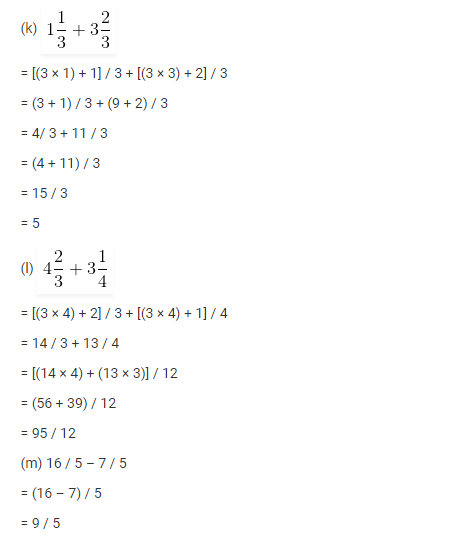
2. Sarita bought 2 / 5 metre of ribbon and Lalita 3 /4 metre of ribbon. What is the total length of the ribbon they bought?
Solutions:
Ribbon length bought by Sarita = 2 / 5 metre
Ribbon length bought by Lalita = 3 / 4 metre
Total length of the ribbon bought by both of them = 2 / 5 + 3 / 4
Taking LCM 20
= [(2 × 4) + (3 × 5)] / 20
= (8 + 15) / 20
= 23 / 20 metre
∴ Total length of the ribbon bought by both Sarita and Lalita is 23 / 20 metre
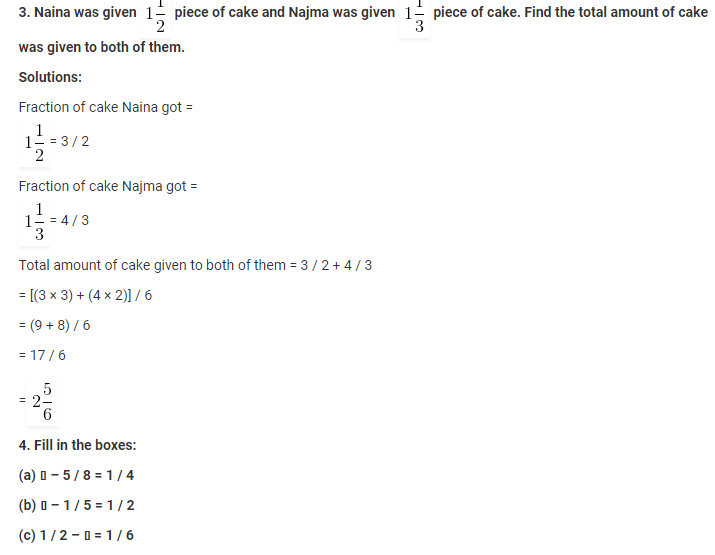
Solutions:
(a) ▯ – 5 / 8 = 1 / 4
▯ = 1 / 4 + 5 / 8
▯ = [(1 × 2 + 5)] / 8
▯ = 7 / 8
(b) ▯ – 1 / 5 = 1 / 2
▯ = 1 / 2 + 1 / 5
▯ = [(1 × 5) + (1 × 2)] / 10
▯ = (5 + 2) / 10
▯ = 7 / 10
(c) 1 / 2 – ▯ = 1 / 6
▯ = 1 / 2 – 1 / 6
▯ = [(1 × 3) – (1 × 1)] / 6
▯ = (3 – 1) / 6
▯ = 2 / 6
▯ 1 / 3
5. Complete the addition and subtraction box.

Solutions:
(a) 2 / 3 + 4 / 3
= (2 + 4) / 3
= 6 / 3
= 2
1 / 3 + 2 / 3
= (1 + 2) / 3
= 3 / 3
= 1
2 / 3 – 1 / 3
= (2 – 1) / 3
= 1 / 3
4 / 3 – 2 / 3
= (4 – 2) / 3
= 2 / 3
1 / 3 + 2 / 3
= (1 + 2) / 3
= 3 / 3
= 1
Hence, the complete given box is
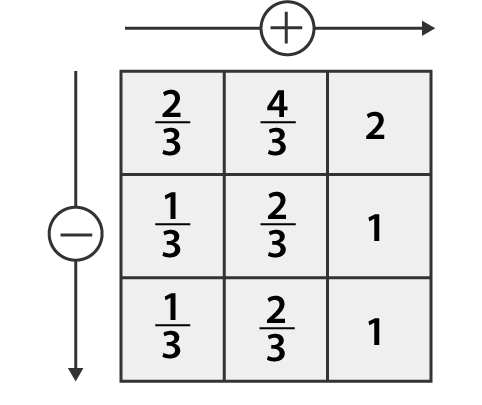
(b) 1 / 2 + 1 / 3
= [(1 × 3) + (1 × 2)] / 6
= (3 + 2) / 6
= 5 / 6
1 / 3 + 1 / 4
= [(1 × 4) + (1 × 3)] / 12
= (4 + 3) / 12
= 7 / 12
1 / 2 – 1 / 3
= [(1 × 3) – (1 × 2)] / 6
= (3 – 2) / 6
= 1 / 6
1 / 3 – 1 / 4
= [(1 × 4) – (1 ×3)] / 12
= (4 – 3) / 12
= 1 / 12
1 / 6 + 1 / 12
= [(1 × 2) + 1] / 12
= (2 + 1) / 12
= 3 / 12
= 1 / 4
Hence, the complete given box is
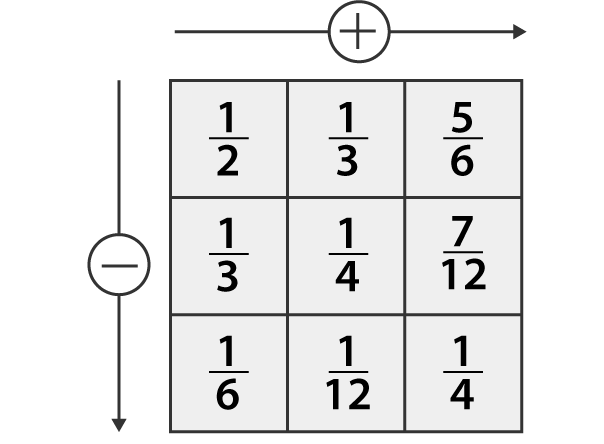
6. A piece of wire 7 / 8 metre long broke into two pieces. One piece was 1 / 4 metre long. How long is the other piece?
Solutions:
Total length of wire = 7 / 8 metre
Length of one piece of wire = 1 / 4 metre
Length of other piece of wire = Length of the original wire and this one piece of wire
= 7 / 8 – 1 / 4
= [(7 × 1) – (1 × 2)] / 8
= (7 – 2) / 8
= 5 / 8
∴ Length of the other piece of wire = 5 / 8 metre
7. Nandini’s house is 9 / 10 km from her school. She walked some distance and then took a bus for 1 / 2 km to reach the school. How far did she walk?
Solutions:
Distance of the school from house = 9 / 10 km
Distance she travelled by bus = 1 / 2 km
Distance walked by Nandini = Total distance of the school – Distance she travelled by bus
= 9 / 10 – 1 / 2
= [(9 × 1) – (1 × 5)] / 10
= (9 – 5) / 10
= 4 / 10
= 2 / 5 km
∴ Distance walked by Nandini is 2 / 5 km
8. Asha and Samuel have bookshelves of the same size partly filled with books. Asha’s shelf is 5 / 6 th full and Samuel’s shelf is 2/ 5 th full. Whose bookshelf is more full? By what fraction?
Solutions:
Fraction of Asha’s bookshelf = 5 / 6
Fraction of Samuel’s bookshelf = 2 / 5
Convert these fractions into like fractions
5 / 6 = 5 / 6 × 5 / 5
= (5 × 5) / (6 × 5)
= 25 / 30
2 / 5 = 2 / 5 × 6 / 6
= (2 × 6) / (5 × 6)
= 12 / 30
25 / 30 > 12 / 30
5 / 6 > 2 / 5
∴ Asha’s bookshelf is more full than Samuel’s bookshelf
Difference = 5 / 6 – 2 / 5
= 25 / 30 – 12 / 30
= 13 / 30
